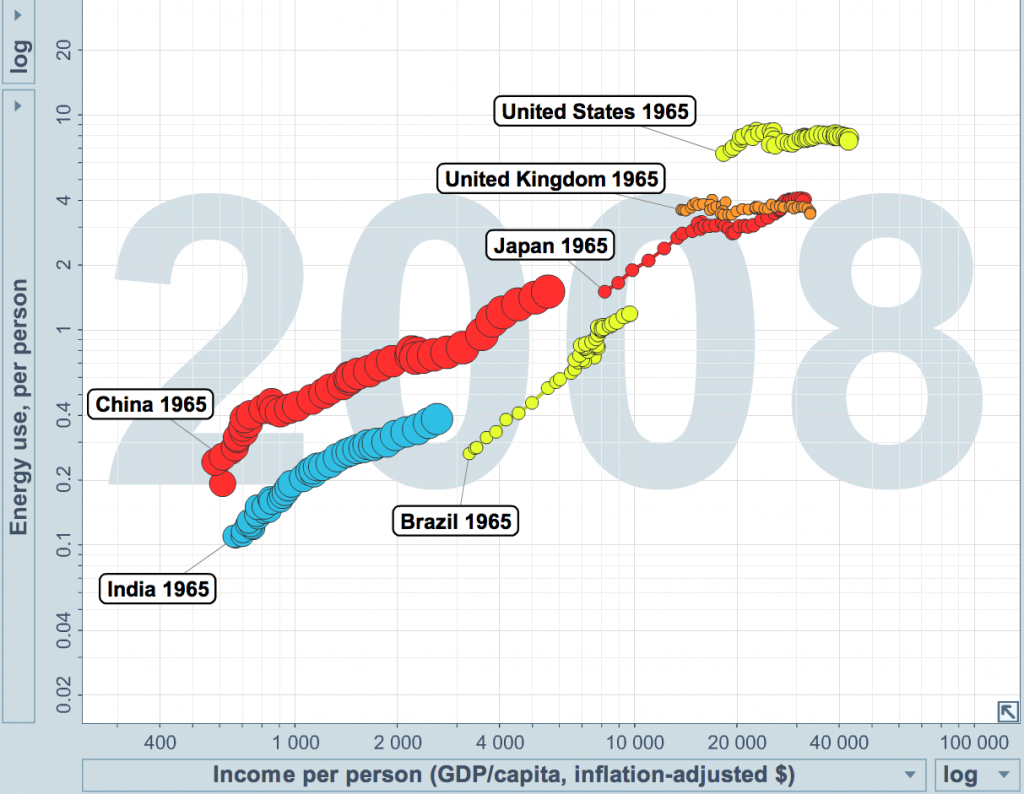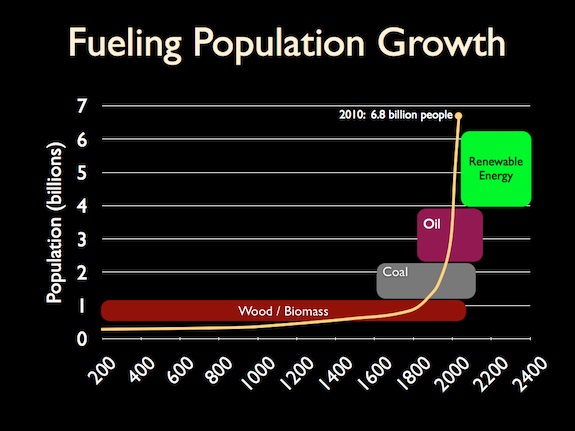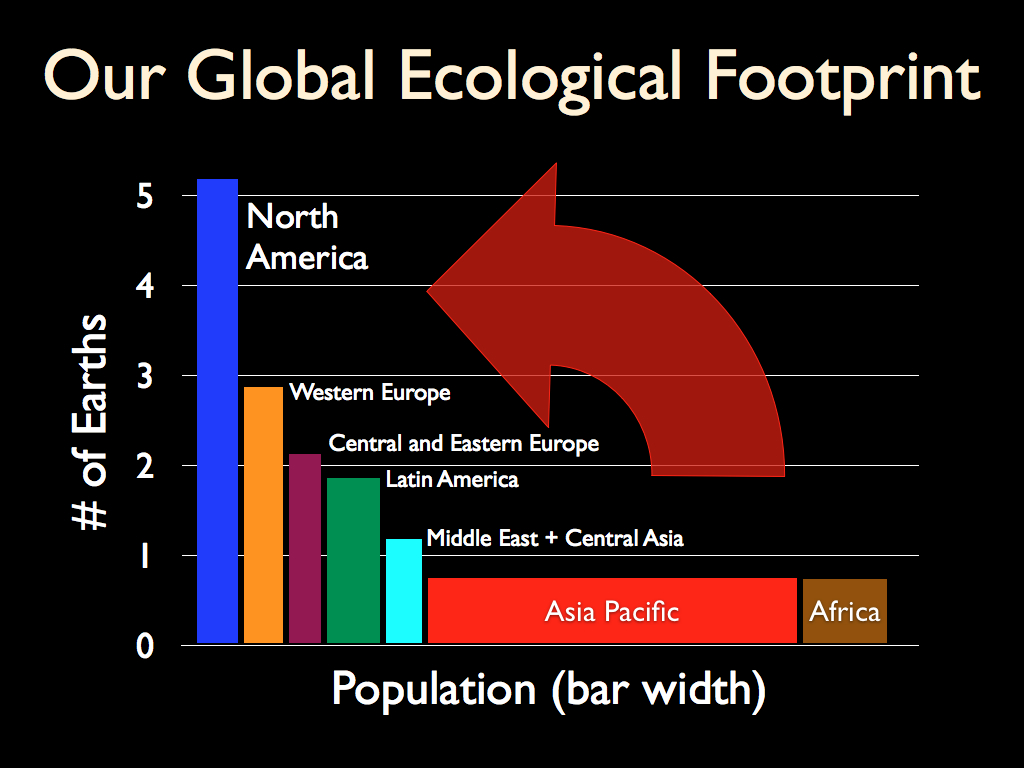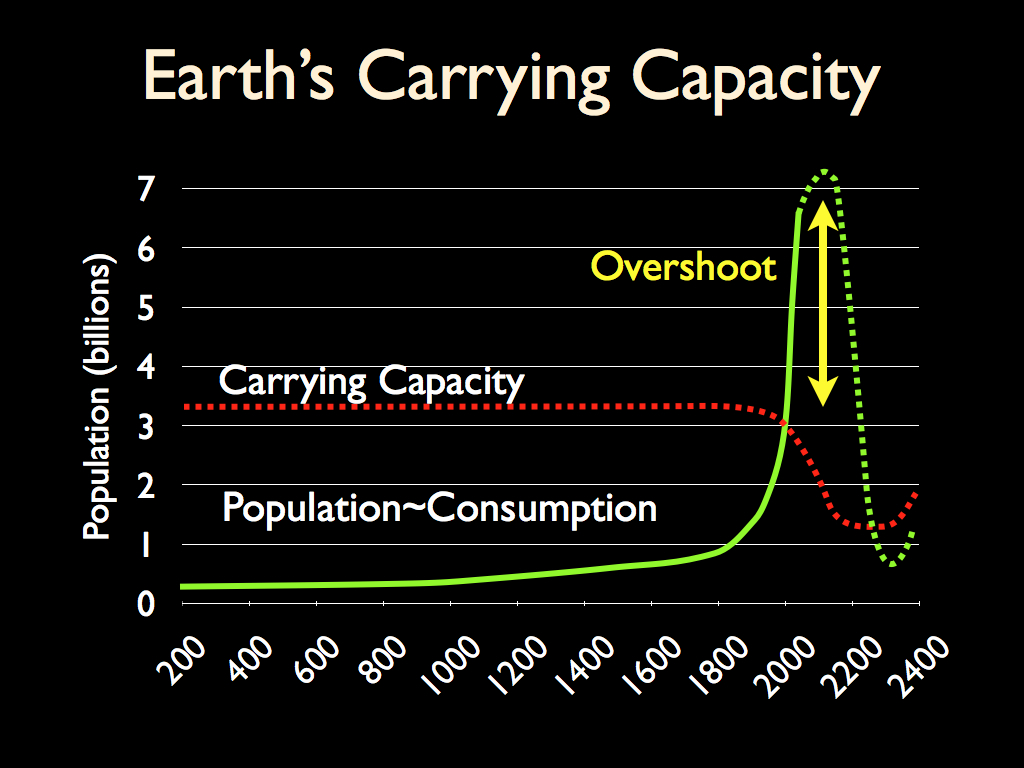Google Trends tells me that starting in 2008 the monthly number of news stories on population doubled. Most of the stories like to talk about how global population will expand by 30%, peaking at about 9.1 billion people by around 2050. Though 2050 is a nice round number, and a convenient mid-century marker, one can be lulled in to feeling like it’s a problem that is 40 years off. Not so. The population problem is here and now. And it’s not just about the number of people on the planet, but how those people consume resources. Let’s take a look at the pertinent trends.
Energy and Population
The rate of population growth has a strong correlation with the effectiveness of the dominant fuel source at any given point in history. As the chart below shows, wood was the dominant fuel until coal came on the scene in the 1600s. The population growth rate increased modestly with the proliferation of coal. But the real exponential growth began with the discovery and exploitation of crude oil. Crude oil production is peaking and the world is in the early stages of a transition from fossil fuels to renewable sources of energy.
China, Brazil and India – Chasing the American Dream
As the population has grown, per capita income and consumption have grown. The most dramatic growth has been in the developing countries of China, Brazil and India. Let’s take a look at the trends in energy use and per capita income relative to some of the leading developed nations. Using GapMinder’s Trendalyzer with energy consumption data from BP’s Statistical Review of World Energy 2010 and income data from the IMF, we can see some powerful trends unfolding (N.B. data presented for 1965 through 2008, 1 year steps, circle area proportional to population size, energy use in tonnes of oil equivalent):
- China, Brazil, and India all show steadily increasing per capita income, with China having the biggest change – outperforming India and Brazil more than 2 to 1.
- Though US per capita energy consumption is substantially larger than China, Brazil or India, growth has been flat. This comes from conservation initiatives (efficient lighting, insulation, etc.). We must do better.
- China, Brazil, and India’s energy consumption is growing quickly as they move toward American patterns of consumption. The trend is strong and steady, with no signs of slowing.

Less Is The New More
Though Americans represent only 5% of the world’s population, we are consuming about 24% of worlds energy. We are similarly voracious consumers of water, food, land, etc. Citizens in developing nations aspire to live the American lifestyle. Fareed Zakaria refers to this as the “rise of the rest” in his book A Post American World. But the world has only so much to give. Much of what we consume is not renewable. We are bumping up against the limits of earth’s ability to provide for us. As the population expands, for developing nations, their historically meager slice of the pie will expand. For developed nations, their slice of the pie must contract.
Our Ecological Footprint
Using ecological footprint data from Global Footprint Network we can see the current state of consumption for North America and the rest of the world (N.B. width of bar proportional to population in associated region).
N.B. Ecological Footprint accounts estimate how many Earths were needed to meet the resource requirements of humanity for each year since 1961, when complete UN statistics became available. Resource demand (Ecological Footprint) for the world as a whole is the product of population times per capita consumption, and reflects both the level of consumption and the efficiency with which resources are turned into consumption products. Resource supply (biocapacity) varies each year with ecosystem management, agricultural practices (such as fertilizer use and irrigation), ecosystem degradation, and weather. This global assessment shows how the size of the human enterprise compared to the biosphere, and to what extent humanity is in ecological overshoot. Overshoot is possible in the short-term because humanity can liquidate its ecological capital rather than living off annual yields.
Carrying Capacity
The last sentence of the note above is important. The developed nations are already consuming beyond the earths capacity to provide. Carrying Capacity has been exceeded and as it is exceeded, Carrying Capacity declines. While developed nations are making headway improving conservation, there has been little reduction of consumption – we have simply slowed the rate of per capita consumption. Meanwhile developing nations are moving up the consumption curve, aiming for an American-class lifestyle. Depletion of earth’s precious resources accelerates – oil, potable water, wild fish, species, clean air, etc. are all in decline. Earth’s Carrying Capacity is thought to be somewhere between 1 and 3 billion people. We have been operating the planet well beyond that for almost 50 years now.
Even if the population stopped growing today, we are consuming beyond the earth’s capacity to provide. With 6.8 billion people already on the planet, the growth of consumption is the population problem, right now.
Zacharia suggests “As each country rises up, they become more self confident and nationalistic, and less inclined to cooperate in global unity toward a common goal of tackling the pressing problems of this century.”
And quoting Hamlet: “There’s the rub.”
- Population has grown beyond the Carrying Capacity of the earth.
- Increasing demand for critical resources (energy, water, food, land, …) reduces Carrying Capacity further, and accelerates decline exponentially.
- Climate is changing, pollution growing, species extinction accelerating.
- And our ability to work cooperatively to meet these challenges is failing.
This is not sustainable.
How do we break the vicious spiral? How can our global economy – grown soft and pudgy during the 20th century’s age of abundance – adapt and function in the lean and mean dog days of the 21st century?



simon says:
We do not break the vicious spiral nature does.
We never planned for this to happen even though such events could and were predicted a long time ago. We carried on for greed and ignored the risk and will only give the problem lip service as it sorts itself out and we reach 1-3 billion the hard way.
People will die and with them the lessons learnt just as it happened before. We were not the first civilisation to make mistakes we are just human.
Roe says:
Those informed will serve as spectators while the vast majority remain confused and angry at the downward trajectory of civilization. Apart from enclaves of concentrated wealth and power due to a talent for social leveraging, the rest will be better off ignoring the temptation to follow in the footsteps of industrial, fossil fuel based civilizations, instead relying on a combination of old agrarian traditions and the application of newly acquired knowledge to make such an approach more efficient and capable of sustaining healthful living conditions. No one will know what time scale this trajectory; precise predictions are of no use, as social cooperation on a sufficiently large scale will not be likely occur. Overshoot and collapse, like peak oil, will likely be taught in history classes among progeny of the elite.
profbam says:
Check out the Doomsday equation in Science vol. 189 p. 86, 1975. The exponential equation accurately predicts earth’s population and has continued to do so through 2005. Because it has a fraction with the denominator that goes to zero in November of 2026, that predicts an infinite population on that date. Impossible, yes. But, the consequences of a near infinite human population are beginning to be seen around the world. The times are going to get worse, much worse.
Jay Kimball says:
The NY Times has a fascinating article today about a social experiment in Kansas, reframing climate change and CO2 challenges, where conservatives talk about their disdain for concern that the climate is warming, but “lamented the nation’s dependence on foreign oil. Some articulated an amorphous desire, often based in religious values, to protect the earth.” The article continues “The project’s strategy seems to have worked. In the course of the program, … energy use in the towns declined as much as 5 percent relative to other areas.” See:
http://www.nytimes.com/2010/10/19/science/earth/19fossil.html?_r=1
Since 60+% of US oil is imported, getting off imported oil will largely require transitioning to renewable energy sources, with the beneficial side-effect of lowering CO2 emissions.
With this social experiment as an example, perhaps there is a way we frame our goals such that we can come together to tackle these population-driven global challenges.
aneisha samuels says:
In my opinion sustainable development is a fancy term used to describe a place that we as a people would like to be in terms of environmental management, social wellbeing and economic prosperity. Ideally, sustainable development on a world level is impossible based on today’s consumption and projected consumptions. A better term would be sustainable living so as to prolong the available limited resources for the benefit of future generation. The earth, like every other natural system goes through a life cycle of birth, growth and death. As an urban planner all we can do is promote green architecture, conservation, re-forestation and subsistent living so as to extend the growth period of the earth, and to postpone its death.
Jay Kimball says:
Thanks for your comment Aneisha. I like the phrase “sustainable living” and I have many friends who endeavor to live sustainably. It is challenging, and takes a lot of thought and awareness. It is also fun. For example, it feels good to be growing food more and getting connected with the whole food cycle.
I have a bunch of chickens, and feed them scraps from the garden, they give me eggs, and lots of chicken poop, which goes into the worm bin, with leftovers from my meals, the worms compost all that, and that compost goes back to the garden to produce more yummy vegetables. It is a beautiful circle!
I have been impressed with how interconnected things are. Food = Water, Food = Energy, etc. It takes water and energy to make food, and the food gives us energy. Work = Energy, it takes energy to drive to work, and so on. To live more lightly, I think it is important to understand what is inside and behind things. I think of it like the idea of “six degrees of separation” – the idea that we are all connected to each other by no more than six people. I know somebody, how knows somebody, who knows somebody, who knows you.
Perhaps the posts that I did on Green GDP might be of interest. See them at:
http://8020vision.com/2009/06/22/nobel-laureate-joseph-stiglitz-on-sustainability-and-growth/
http://8020vision.com/2010/07/19/rethinking-the-measure-of-growth/
Aneisha samuels says:
i am a student at the university of technology, Jamaica and i published an article which i think you mite also find interesting:
http://www.scribd.com/doc/45235465/The-Spatial-Framework-ppt-Draft
Tom says:
test
G K Chetty says:
This whole site is covered our concern for the planet quite apptly. I can only say that the developed nations have reached a pleatue in their growth. Regardless of the automation they have there, the strength of working manpower has reduced considrably. On the contrary the developing nations BRIC have the work force but that gets cancelled by the population growth.Thus the two group have to work together to address the global issues. “Can this happen?” looks diffficult.
Corax says:
We think we are better than the animals in the natural world, but we are subject to the same principles that hold true in nature …. we are just able to forestall the inevitable a bit longer. Since we didn’t chose to control ourselves, nature will chose for us … famine, war, and disease. Hold on, folks, it’s going to be a bumpy ride!
Frolickstein says:
Hey, I saw your graph, and was curious if you had a citation for that 1-3 billion capacity figure. I’d love to be able to include it in an essay, but it’s somewhat of a baseless statement as is.
jaykimball says:
That came from a survey of various studies on carrying capacity. The range is highly dependent on a populations lifestyle. High consuming groups deplete the land with a lower population, and low consuming populations can live on the land with higher densities. Signs that a population has exceeded the carrying capacity include species extinction, water resource depletion, soil depletion, food production limits per unit of land, waste build-up. etc.
Global Footprint Network has a very detailed analysis at their site.
For more info on the low end of the range, see Cornell University Professor David Pimentel 1999 paper “How Many Americans can the Earth Support?”